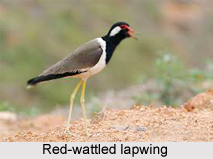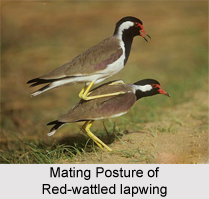 Red-Wattled Lapwing is an Indian Bird that bears a scientific name "Vanellus indicus". It is a bird of Lapwing or large plover, a wader in the family Charadriidae.
Red-Wattled Lapwing is an Indian Bird that bears a scientific name "Vanellus indicus". It is a bird of Lapwing or large plover, a wader in the family Charadriidae.
Sounds of Red-Wattled Lapwing
Red-Wattled Lapwing has characteristic loud alarm call which are variously rendered as did the male Red-Wattled Lapwing do it or pity to do it, leading to colloquial names like the did-he-do-it bird. Usually seen in pairs or small groups not far from water but may form large flocks in the non-breeding season (winter).
Structure of Red-Wattled Lapwing
Red-Wattled Lapwings are large waders, about 35 cm long. The wings and back are light brown with a purple sheen, but head and chest and front part of neck are black. Prominently white patch runs between these two colours, from belly and tail, flanking the neck to the sides of crown. Short tail is tipped black. A red fleshy wattle in front of each eye, black-tipped red bill, and the long legs are yellow. In flight, prominent white wing bars formed by the white on the secondary coverts.
Concentration of Red-Wattled Lapwing
The race of Red-Wattled Lapwing is slightly paler and larger than the nominate race and is found in Turkey, Iran, Iraq, Afghanistan and the Indus valley. The nominate race of Red-Wattled Lapwing is found in all the states of India. The Sri Lankan race lankae is smaller and dark while atronuchalis the race in north-eastern India and eastern Bangladesh has a white cheek surrounded by black.
Sexes of Red-Wattled Lapwing
The males and females Red-wattled lapwing are similar in plumage but males have a 5 percent longer wing and tend to have a longer carpal spur. The length of Red-wattled lapwing is 320-350mm, wing of 208-247mm with the nominate averaging 223mm, Sri Lanka 217mm. The Bill of Red-wattled lapwing is 31-36mm and tarsus of 70-83mm. Tail length is 104-128mm.
Behaviours of Red-Wattled Lapwing
Red-wattled lapwing usually keeps in pairs or trios in well-watered open country, ploughed fields, grazing land, and margins and dry beds of tanks and puddles. They occasionally form large flocks, ranging from 26 to 200 birds. It is also found in forest clearings around rain-filled depressions. It runs about in short spurts and dips forward obliquely (with unflexed legs) to pick up food in a typical plover manner.
Feedings of Red-Wattled Lapwing
Red-Wattled Lapwings are said to feed at night being especially active around the full moon. The feedings of Red-Wattled Lapwings includes a range of insects, snails and other invertebrates, mostly picked from the ground. They may also feed on some grains. Red-Wattled Lapwings feed mainly during the day but they may also feed at night. They may sometimes make use of the legs to disturb insect prey. Red-Wattled Lapwings are uncannily and ceaselessly vigilant in day or night. It is the first to detect intrusions and raise an alarm, and was therefore considered a nuisance by hunters. The flight of Red-Wattled Lapwings is slow, with deliberate flaps, but capable of remarkable agility when defending nest or being hunted by the birds of hawk family.
Language of Red-Wattled Lapwing
The local names of Red-Wattled Lapwings are mainly onomatopoeic in origin and include titeeri (Hindi Language), tittibha (Kannada Language), tateehar (Sindhi Language), titodi (Gujarati Language), hatatut (Kashmiri Language), balighora (Assamese Language), yennappa chitawa (Telugu Language), aal-kaati (Tamil language).
Breeding of Red-Wattled Lapwings
Red-Wattled Lapwings breed from West Asia which includes Iraq, South West Iran, Arabian Sea and Persian Gulf eastwards across South Asian countries of dry and arid region; Baluchistan, Afghanistan, Pakistan, the entire Indian subcontinent up to Kanyakumari and up to 1800meters in Jammu and Kashmir to Nepal, with another sub-species further east in Southeast Asia. This species is declining in its western range, but is abundant in much of South Asia, being seen at almost any wetland habitat in its range. The breeding season is mainly March to August. The courtship involves the male Red-wattled lapwings puffing its feathers and pointing its beak upwards.



















